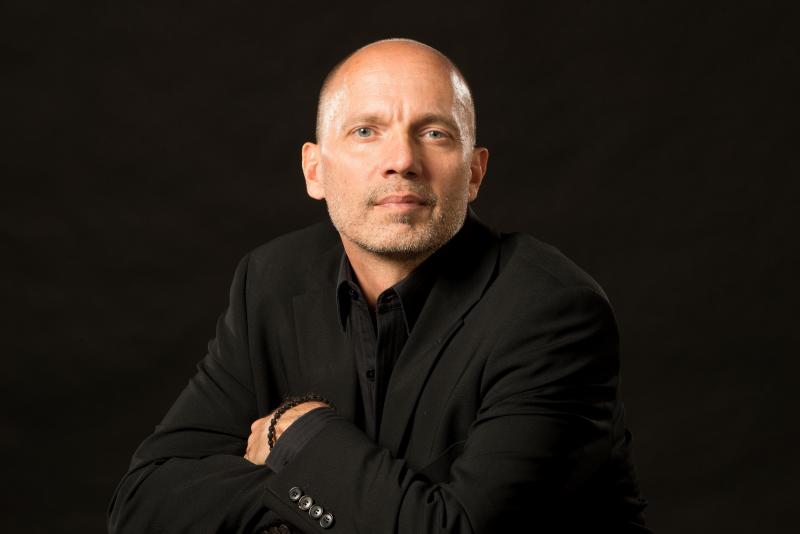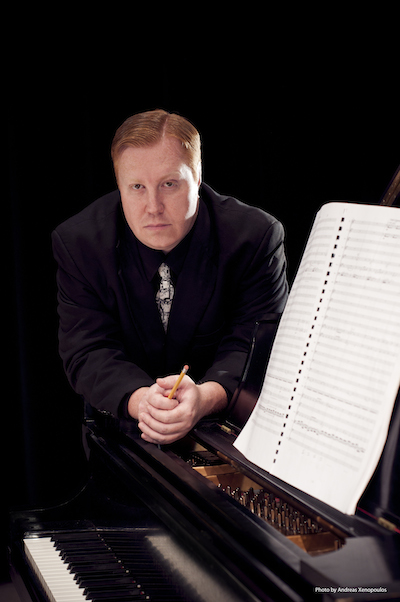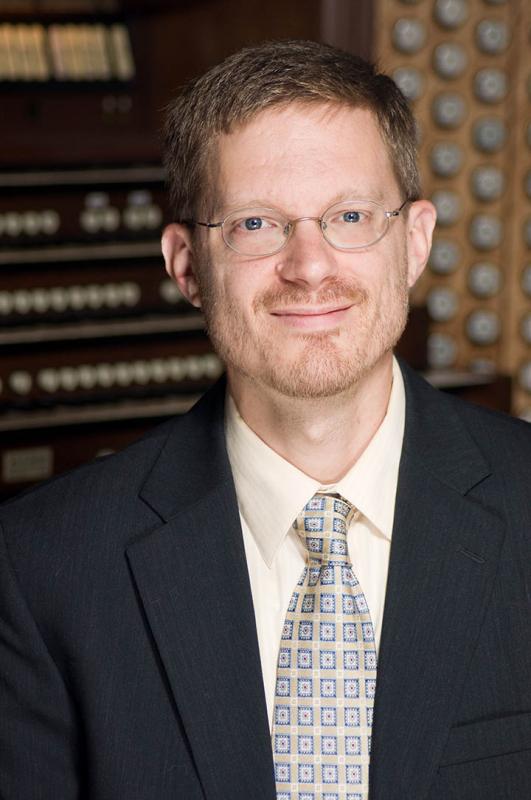The halls of the Westbrook Music Building are once again busy and our faculty, staff, students and alumni are all doing amazing things! Read about them here:

Christopher Barrick
Dr. Christopher Barrick now serves as the Department Head of Music and Theatre, and the James & Ann Bumpass Distinguished Chair of Music, at the University of Arkansas - Fort Smith. As Associate Professor of Music, he directs the UAFS Jazz Band and teaches applied saxophone. Barrick is an alum of the Glenn Korff School of Music (DMA, 2008).

Christopher Marks
Christopher Marks will give a recital of organ music by Seth Bingham at First-Plymouth Congregational Church in Lincoln on Friday, October 10, 7:30 pm. This recital serves as a live preview of a recording session that will take place just a few days later. The recording will be the third in a series of CDs by Marks, devoted to Bingham's organ music. Seth Bingham (1882-1972) was a prolific American composer and church musician who was active in New York throughout his professional life. He taught at Columbia and Union Theological Seminary and was director of music at Madison Avenue Presbyterian Church. The Lied Organ at First-Plymouth is an ideal vehicle for Bingham's colorful compositions, which demonstrate the incredible depth and variety of sound of the organ. Admission is free; a free-will offering will be collected to benefit music at First-Plymouth.

Mark Clinton
Review of Mark Clinton's September 18 performance
Clarity, innovation mark engaging, transparent recital at Kimball
By John Cutler, Frequent reviewer for the Lincoln Journal-Star
Mark Clinton, DMA, co-chair of the Keyboard Area at the Glenn Korff School of Music in the Hixson-Lied College of Fine and Performing Arts at UNL, presented a faculty recital in Kimball Hall on Thursday evening.
Clinton’s undertakings included Robert Schumann’s “Arabeske” in C major Op. 18; the eternal Beethoven “Piano Sonata in f minor, Op. 57” (Appassionata); Nocturne in D-flat major, Op. 27, No. 2 and the often-played “Polonaise” in A-Flat major, Op. 53 of Frederic Chopin; the complete “Klavierstücke,” Op. 119 of Johannes Brahms; and a transcription of Jean Sibelius’ “Finlandia” op. 26, often heard in symphonic concerts but arranged for piano by the composer shortly after its composition in 1899.
With the engaging “Arabeske” Clinton laid out his strategy for the evening: to present, in unfettered accuracy but with an emotional underpinning, just how clear and purposeful piano music can be. The subtle contrasts of the main theme with the ensuing alternate sections were a pleasant discourse on Schumann’s surroundings at the time of the composition.
Much more challenging, in a way, was the Beethoven war-horse. The challenge would be to do something different from the Dinersteins, the Axes, and the oft-noted Leon Fleischer (who was Clinton’s mentor at Peabody).
So, from the opening Allegro assai, it appeared Clinton would aim the course of “Appassionata” in a direction different from the deep-Romantic approach, perhaps not taking on the now-popular “early classic” garb that surrounds the noted composer but rather letting some air and light into the piece while keeping the robust emotional ambience.
Phrasings that traditionally ended with swells appeared with diminuendos. Others that have traditionally been marked with ritardando received a steady-course-to-advance approach. After a few measures to analyze what went on, this reviewer noted a sense of logic in Clinton’s minor changes.
For the famed second movement, audience members appeared moved. Some smiled. Some meditated. A few of the longtime concert-goers appeared to be sad, perhaps remembering bygone days with loved ones. This was an emotional time both for Clinton and his followers, and the pianist again let his feelings spill out on the keys.
The final movement ripped by like Amtrak on the Nebraska plains. Yet Clinton was careful not to let the allegro ma non troppo get too troppo and run away with it. Control, plus Clinton’s unerring fingering on runs and repeated notes, helped keep the final movement on its tumultuous course.
The two Chopin pieces that led off the second half of the program were delightful, the Nocturne being a good contrast for the strong Polonaise. Clinton’s restraint combined with a sense of empathy in the Nocturne allowed the elegant melodic treatment to magically unfold.
The Polonaise, on the other hand, was a great demonstration of Polish musical might. The dynamic shadings, coupled with Clinton’s determined stance at the keyboard, combined to give this work the Carnegie Hall perfect polish Clinton sought in his interpretation.
The audience had awaited the four pieces of Brahms’ “Klavierstücke” knowing .the pieces are often presented individually as encores or specialty pieces in concert. The sweet-sour timbre of the first “Intermezzo” was a good scene-setter for the three works that followed.
Brahms’ rhythms and phrasing are unique in these works. Clinton did his best to musically set-out the phrases in an interpretation the 350 patrons could consume. The concluding “Rhapsodie” is of different phrasing construction than most and Clinton took advantage of this to again display his uncanny ability to bring clarity and meaning to the uniqueness of this work.
Most of us have heard the sweeping “Finlandia” in big Romantic orchestral recordings. Few of us have heard the concert piano solo version, though it was adapted by Sibelius just shortly after he completed the orchestral tone poem.
Sibelius was no schlock at piano interpretation and understanding, and in fact had this piece in mind for a concert pianist-colleague of his. It has all the trappings of a Rachmaninoff or Rubinstein. For an audience seasoned by the perennial orchestral favorite, patrons would be looking for the nuances of the various instruments in the piano interpretation.
Clinton needed to be careful in his evocation. His attention to detail within the individual phrases, even one- or two-note emphasis in this score, was a harbinger of the sweeping hymn-tune conclusion. The lines fell into place, just as in the mighty orchestral work.
The hymn-tune layout following the commotion of the introduction was simply dazzling. Its modest entrance even caught patrons off-guard and the procession through the melody development was intricately engineered by Clinton to achieve a glorious, ringing finale.
The Kimball audience felt so too and immediately patrons arose and offered cheers and resounding applause.
A third curtain call for the pianist demanded an encore, and Clinton obliged, with a rarely-heard Egon Petri arrangement of the aria “Sheep May Safely Graze” from Bach’s “Hunt” Cantata, BWV 208. The performance was again, in the concept of Clinton’s evening of education and transparency, a delicate gem capping off a triumphant evening of piano repertoire revelations.
Watch the performance: https://www.youtube.com/watch?v=kYtDODcXnRU
Percussion Studio
Here are some summer achievements of the Percussion Studio students, including by those who participated in the Santa Clara Vanguard at DCI Finals this year: Cory Davis (new masters student) taught the group and Paige DeDecker (freshmen this year) was a performer. According to Glenn Korff School of Music's Assistant Professor of Percussion and Jazz Studies Dave Hall, to win the award for best percussion performance is incredibly difficult, and one of the biggest achievements in contemporary percussion performance.
Nick Johnson (Sr.) Performed in Xi’an, China with a jazz quartet comprised of fellow students from the Glenn Korff School of Music.
Ian McCollum (Sr.) Attended two prestigious festivals in the United States this summer: The Chosen Vale Percussion Seminar in New Hampshire; and the So Percussion Summer Institute (SoSI) at Princeton University where he worked with acclaimed Brooklyn-based quartet So Percussion.
Matt Rush (DMA) was an instructor at the Yamaha “Sounds of Summer” camp in Fort Worth, TX.
Paige DeDecker (Fr.) performed on vibraphone with the Santa Clara Vanguard (Santa Clara, California). SCV’s country-wide tour concluded at the Drum Corps International Finals in Indianapolis, where the group took fourth over all and won the coveted Fred Sanford Award for best percussion performance.
Cory Davis (MM) was on tour as part of the instructional staff for the Santa Clara Vanguard and helped lead the group to the 2014 Fred Sanford High Percussion Award this summer.
Alex Woodside (So.) attended the Leigh Howard Stevens Summer Marimba Seminar and Mallet Masters Festival in Ocean Grove, New Jersey where he interacted with Eric Sammut, Blake Tyson, Kevin Bobo, Mike Burritt, Tom Burritt, and other outstanding guest artists from around the country.
Dr. Dave Hall performed at the Montreux Jazz Festival in Switzerland and the Jazz á Vienne Festival in France.

Paul Barnes
I'm the headlining pianist for the Christian Fellowship of Art Music Composers National Convention in Los Angeles. I'll be giving the opening recital on October 9 at Biola University and will be featured on the October 10 recital as well. The recitals feature compositions from several young and upcoming composers.

Daniel Baldwin

Bobby Fuson II
This summer I worked as the coordinator of the Nebraska Jazz Orchestra, Nebraska Jazz Camp, and Lincoln Municipal Band. I had my first big band composition published by UNC Jazz Press, and I was named adjunct instructor of saxophone at Doane College this year. I was commissioned to write a piece for my alma mater, the University of the Cumberlands, and their jazz ensemble to celebrate David Threlkeld's 20 years of service to the school. The chart was premiered in Williamsburg, Kentucky on April 10 and received its Nebraska premiere by the UNL Jazz Orchestra on April 25.

Christopher Marks
I’m excited to be back in Syracuse, NY, this week for the 2014 convention of the Organ Historical Society. I’ll be playing a recital program on Tuesday afternoon for the convention, on an organ built in 1872 by J.H. Willcox in St. Cecilia Catholic Church. I’ll be performing a newly commissioned piece by Kurt Knecht. Here are a couple of pictures of the instrument …http://www.christophermarksorganist.com/?p=111


Janka Krajciova
The International Music Institute and Festival USA 2014 took place on the beautiful campus of Mount St. Mary’s University in Emmitsburg, MD from July 14-24 and I was able to attend due to a generous Hixson-Lied summer study grant. In addition to lessons, coachings, performances and masterclasses, the festival also included seminar in performance psychology, theatre workshop and daily yoga morning stretches. The following five-day tour around cities of Thurmont, Annapolis, Towson, Bel Air and Baltimore featured eight of us from the IMIF. We performed a total of seven concerts in various venues, including a mountain retreat lodge, retirement centers and many gorgeous churches. There was also time for friendships, sight-seeing, ice cream and trying local foods, my favorite being charming Annapolis, historic Hampton Mansion in Towson and of course, Maryland crabcakes! Needless to say, I had a blast!
Tass Schweiger and Christina Ensign
The past 5 weeks, we have been working as Counselors at the New York Summer Music Festival. We sent in our applications and audition tapes back in January and were notified of our positions in April. We began the 22 hour drive to Oneonta, New York on June 30 and will be headed back on August 4.
While at NYSMF, Tass (oboe) has been a part of the Chamber Orchestra, Wind Ensemble, Double Reed Trio, Mixed Woodwind Trio, Double Reed Institute, and All NYSMF choir.
At NYSMF, Christina (clarinet) has participated in Chamber Orchestra, Wind Ensemble, Clarinet Quartet, Mixed Woodwind Trio (with Tass!), Jazz Combo (playing jazz clarinet), and Lab Jazz (playing trombone), a collaborative faculty/staff performance of "Carnival of Animals", and All NYSMF choir. She has also been teaching a Theory 1 class each morning to a class of approximately 20 students.
Along with ensembles, we have had opportunities to take lessons, participate in master classes, and listen to concerts given by various guest artists from around the world. We even found some spare time to take a beginning guitar class (We can now play about 5 chords and "Love Me Tender"!) and got some fantastic ice cream!